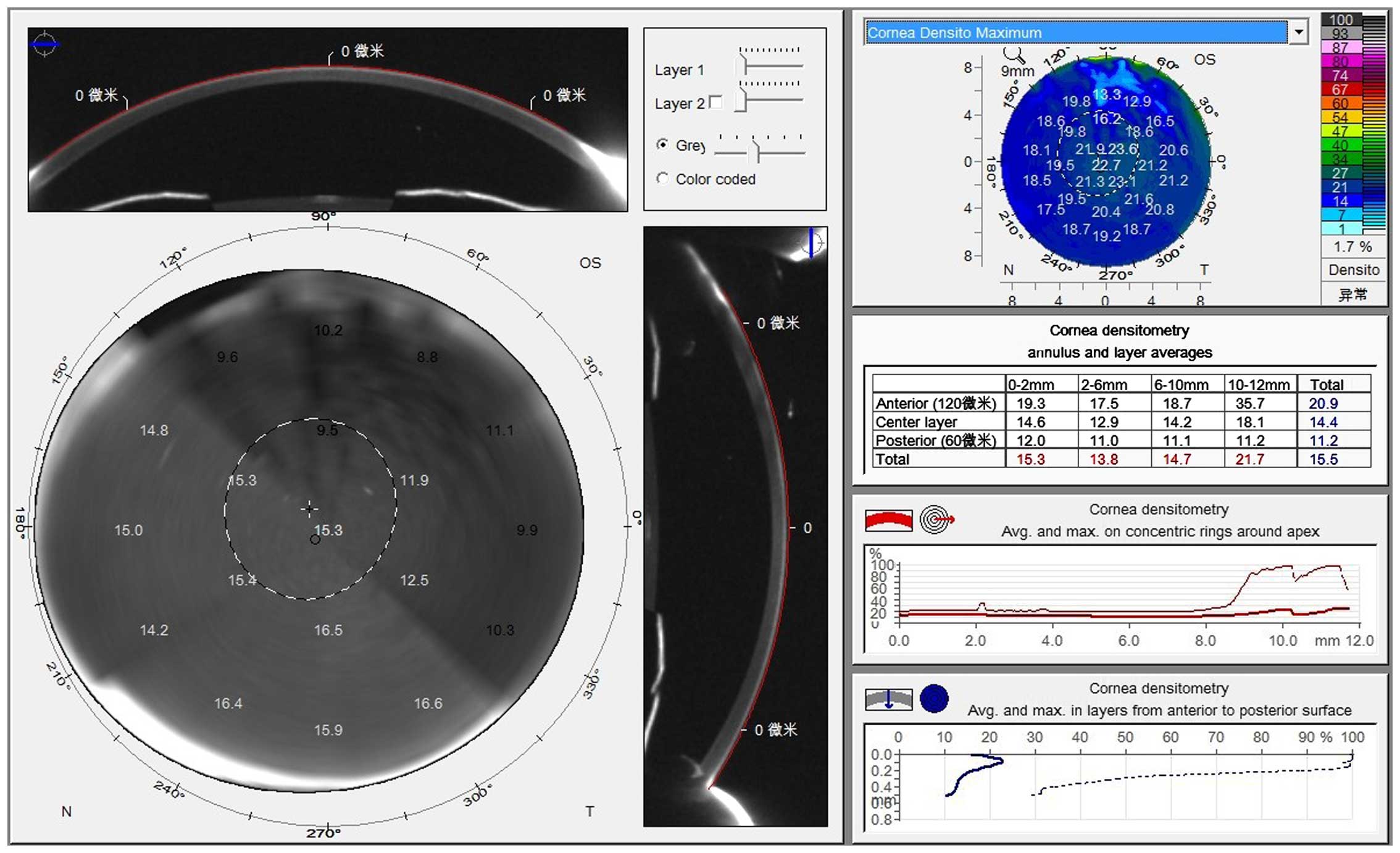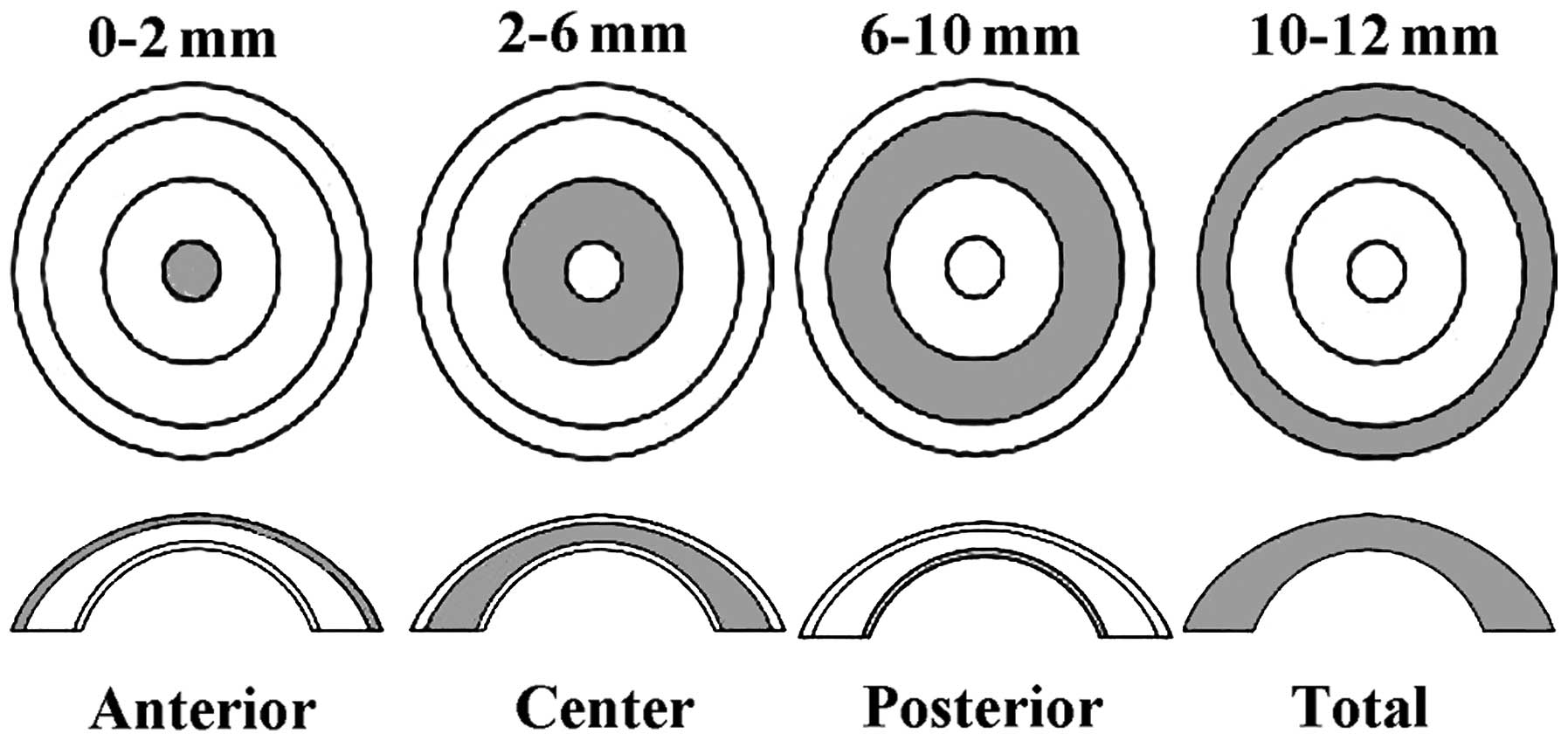|
1
|
Wang Y, Zhou Q and Xie L: Diabetic
keratopathy: new progresses and challenges. Zhonghua Yan Ke Za Zhi.
50:69–72. 2014.(In Chinese). PubMed/NCBI
|
|
2
|
Kaji Y: Prevention of diabetic
keratopathy. Br J Ophthalmol. 89:254–255. 2005. View Article : Google Scholar : PubMed/NCBI
|
|
3
|
Cennamo G, Forte R, Aufiero B and La Rana
A: Computerized Scheimpflug densitometry as a measure of corneal
optical density after excimer laser refractive surgery in myopic
eyes. J Cataract Refract Surg. 37:1502–1506. 2011. View Article : Google Scholar : PubMed/NCBI
|
|
4
|
Rosales P and Marcos S: Pentacam
Scheimpflug quantitative imaging of the crystalline lens and
intraocular lens. J Refract Surg. 25:421–428. 2009. View Article : Google Scholar : PubMed/NCBI
|
|
5
|
Lanza M, Cennamo M, Iaccarino S, Romano V,
Bifani M, Irregolare C and Lanza A: Evaluation of corneal
deformation analyzed with a Scheimpflug based device. Cont Lens
Anterior Eye. 38:89–93. 2015. View Article : Google Scholar : PubMed/NCBI
|
|
6
|
Kolb H and Mandrup-Poulsen T: The global
diabetesepidemic as a consequence of lifestyle-induced low-grade
inflammation. Diabetologia. 53:10–20. 2010. View Article : Google Scholar : PubMed/NCBI
|
|
7
|
Takacs AI, Mihaltz K and Nagy ZZ: Corneal
density with the Pentacam after photorefractive keratectomy. J
Refract Surg. 27:269–277. 2011. View Article : Google Scholar : PubMed/NCBI
|
|
8
|
Hillenaar T, van Cleynenbreugel H, Verjans
GM, Wubbels RJ and Remeijer L: Monitoring the inflammatory process
in herpetic stromal keratitis: the role of in vivo confocal
microscopy. Ophthalmology. 119:1102–1110. 2012. View Article : Google Scholar : PubMed/NCBI
|
|
9
|
Hamrah P, Cruzat A, Dastjerdi MH, Zheng L,
Shahatit BM, Bayhan HA, Dana R and Pavan-Langston D: Corneal
sensation and subbasal nerve alterations in patients with herpes
simplex keratitis: an in vivo confocal microscopy study.
Ophthalmology. 117:1930–1936. 2010. View Article : Google Scholar : PubMed/NCBI
|
|
10
|
Vivino MA, Chintalagiri S, Trus B and
Datiles M: Development of a Scheimpflug slit lamp camera system for
quantitative densitometric analysis. Eye (Lond). 7:791–798. 1993.
View Article : Google Scholar : PubMed/NCBI
|
|
11
|
Greenstein SA, Fry KL, Bhatt J and Hersh
PS: Natural history of corneal haze after collagen crosslinking for
keratoconus and corneal ectasia: Scheimpflug and biomicroscopic
analysis. J Cataract Refract Surg. 36:2105–2114. 2010. View Article : Google Scholar : PubMed/NCBI
|
|
12
|
Fares U, Otri AM, Al-Aqaba MA, Faraj L and
Dua HS: Wavefront-optimized excimer laser in situ keratomileusis
for myopia and myopic astigmatism: refractive outcomes and corneal
densitometry. J Cataract Refract Surg. 38:2131–2138. 2012.
View Article : Google Scholar : PubMed/NCBI
|
|
13
|
Otri AM, Fares U, Al-Aqaba MA and Dua HS:
Corneal densitometry as an indicator of corneal health.
Ophthalmology. 119:501–508. 2012. View Article : Google Scholar : PubMed/NCBI
|
|
14
|
Constantinou M, Jhanji V, Tao LW and
Vajpayee RB: Clinical review of corneal ulcers resulting in
evisceration and enucleation in elderly population. Graefes Arch
Clin Exp Ophthalmol. 247:1389–1393. 2009. View Article : Google Scholar : PubMed/NCBI
|
|
15
|
Kaji Y, Usui T, Oshika T, Matsubara M,
Yamashita H, Araie M, Murata T, Ishibashi T, Nagai R, Horiuchi S
and Amano S: Advanced glycation end products in diabetic corneas.
Invest Ophthalmol Vis Sci. 41:362–368. 2000.PubMed/NCBI
|
|
16
|
Konstantopoulos A, Kuo J, Anderson D and
Hossain P: Assessment of the use of anterior segment optical
coherence tomography in microbial keratitis. Am J Ophthalmol.
146:534–542. 2008. View Article : Google Scholar : PubMed/NCBI
|
|
17
|
Konstantopoulos A, Hossain P and Anderson
DF: Recent advances in ophthalmic anterior segment imaging: a new
era for ophthalmic diagnosis? Br J Ophthalmol. 91:551–557. 2007.
View Article : Google Scholar : PubMed/NCBI
|
|
18
|
Daxer A, Misof K, Grabner B, Ettl A and
Fratzl P: Collagen fibrils in the human corneal stroma: structure
and aging. Invest Ophthalmol Vis Sci. 39:644–648. 1998.PubMed/NCBI
|
|
19
|
Wegener A and Laser-Junga H: Photography
of the anterior eye segment according to Scheimpflug's principle:
options and limitations - a review. Clin Experiment Ophthalmol.
37:144–154. 2009. View Article : Google Scholar : PubMed/NCBI
|
|
20
|
Alsbirk PH: Corneal thickness. I. Age
variation, sex difference and oculometric correlations. Acta
Ophthalmol (Copenh). 56:95–104. 1978. View Article : Google Scholar : PubMed/NCBI
|
|
21
|
Keoleian GM, Pach JM, Hodge DO, Trocme SD
and Bourne WM: Structural and functional studies of the corneal
endothelium in diabetes mellitus. Am J Ophthalmol. 113:64–70. 1992.
View Article : Google Scholar : PubMed/NCBI
|
|
22
|
Cho YK, Chang HS, La TY, Ji D, Kim H, Choi
JA and Kim MS: Anterior segment parameters using Pentacam and
prediction of corneal endothelial cell loss after cataract surgery.
Korean J Ophthalmol. 24:284–290. 2010. View Article : Google Scholar : PubMed/NCBI
|
|
23
|
Buehl W, Stojanac D, Sacu S, Drexler W and
Findl O: Comparison of three methods of measuring corneal thickness
and anterior chamber depth. Am J Ophthalmol. 141:7–12. 2006.
View Article : Google Scholar : PubMed/NCBI
|
|
24
|
Matsuda J, Hieda O and Kinoshita S:
Quantification of corneal opacity after refractive corneal surgery
using the anterior segment analyzer. Nippon Ganka Gakkai Zasshi.
111:447–453. 2007.(In Japanese). PubMed/NCBI
|
|
25
|
Shankar H, Taranath D, Santhirathelagan CT
and Pesudovs K: Anterior segment biometry with the Pentacam:
comprehensive assessment of repeatability of automated
measurements. J Cataract Refract Surg. 34:103–113. 2008. View Article : Google Scholar : PubMed/NCBI
|
|
26
|
Vemuganti GK, Reddy K, Iftekhar G, Garg P
and Sharma S: Keratocyte loss in corneal infection through
apoptosis: a histologic study of 59 cases. BMC Ophthalmol.
4:162004. View Article : Google Scholar : PubMed/NCBI
|
|
27
|
Vesaluoma M, Pérez-Santonja J, Petroll WM,
Linna T, Alió J and Tervo T: Corneal stromal changes induced by
myopic LASIK. Invest Ophthalmol Vis Sci. 41:369–376.
2000.PubMed/NCBI
|
|
28
|
Erie JC, Patel SV, McLaren JW, Hodge DO
and Bourne WM: Keratocyte density in the human cornea after
photorefractive keratectomy. Arch Ophthalmol. 121:770–776. 2003.
View Article : Google Scholar : PubMed/NCBI
|











